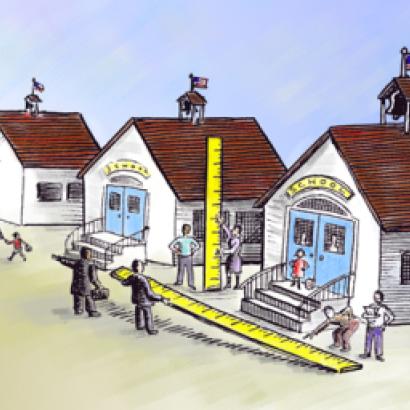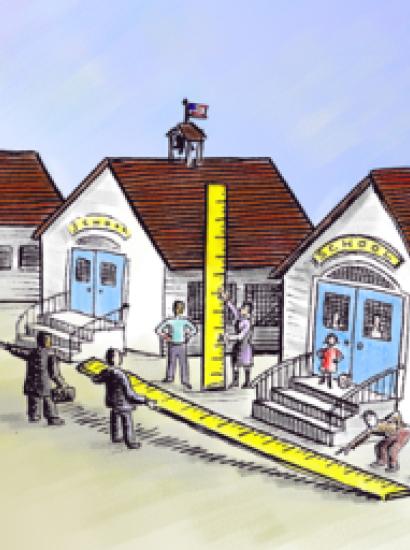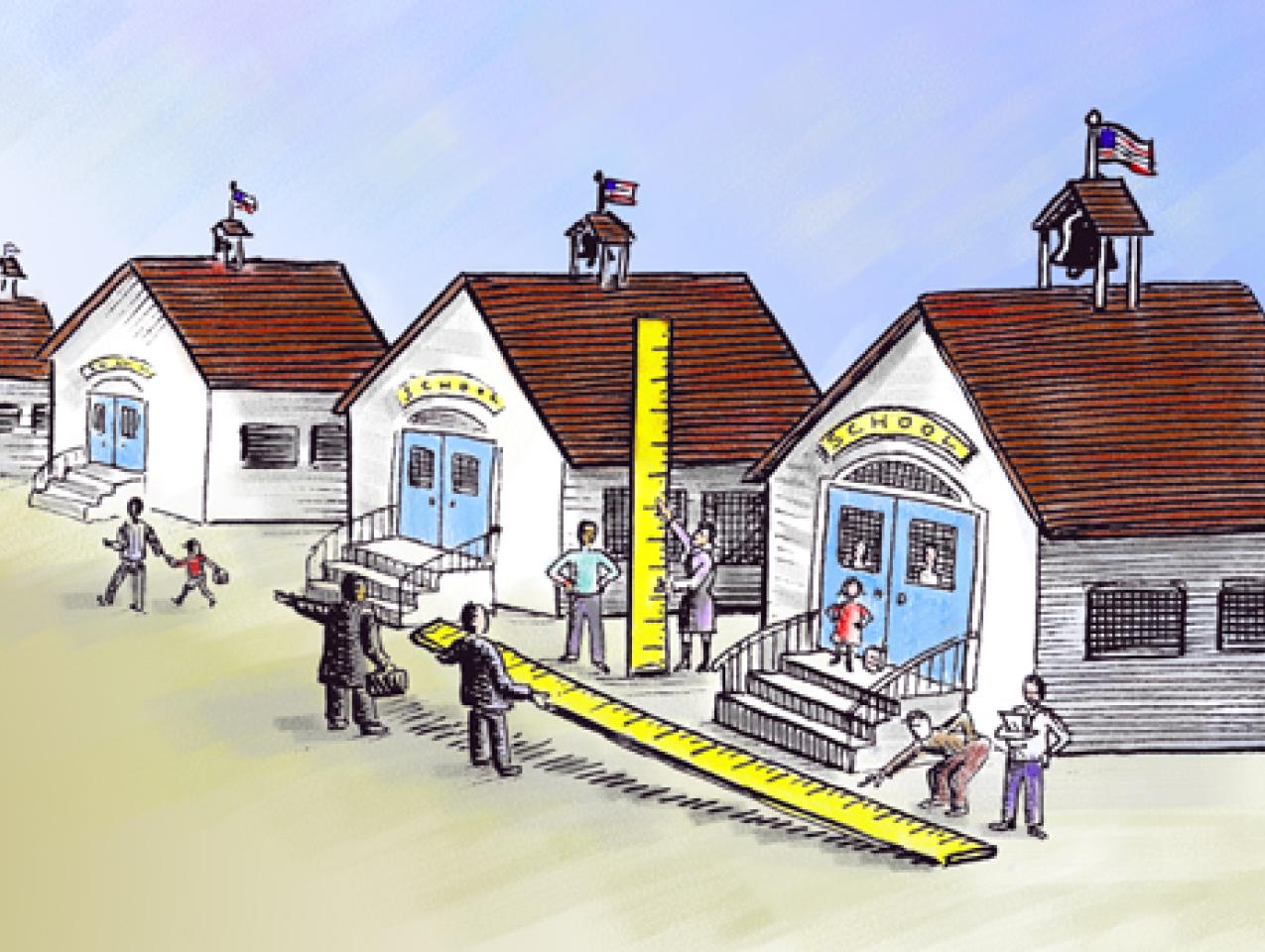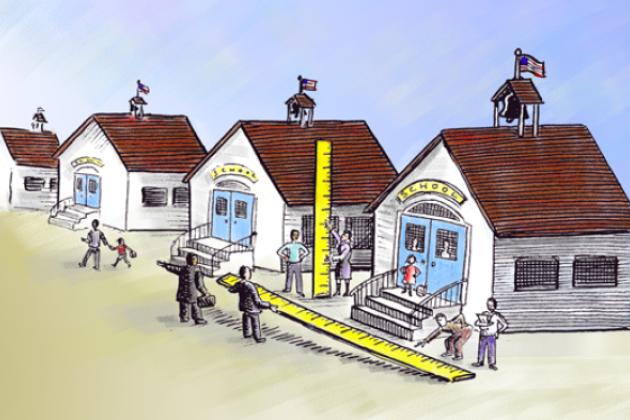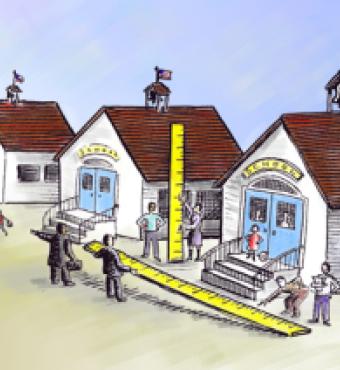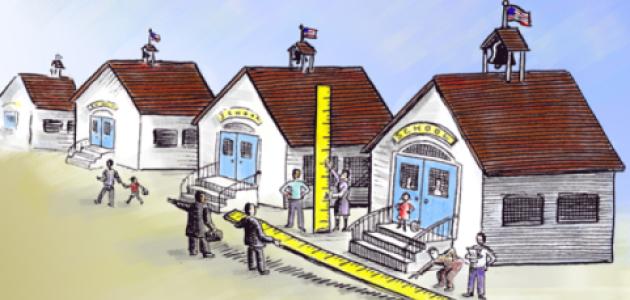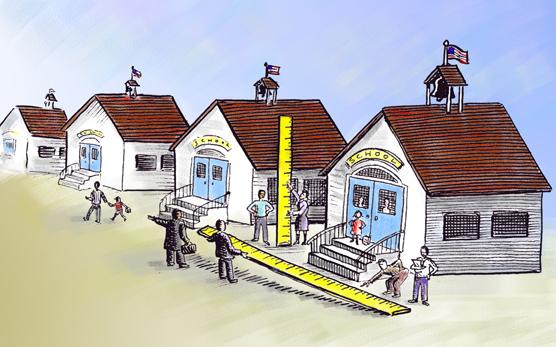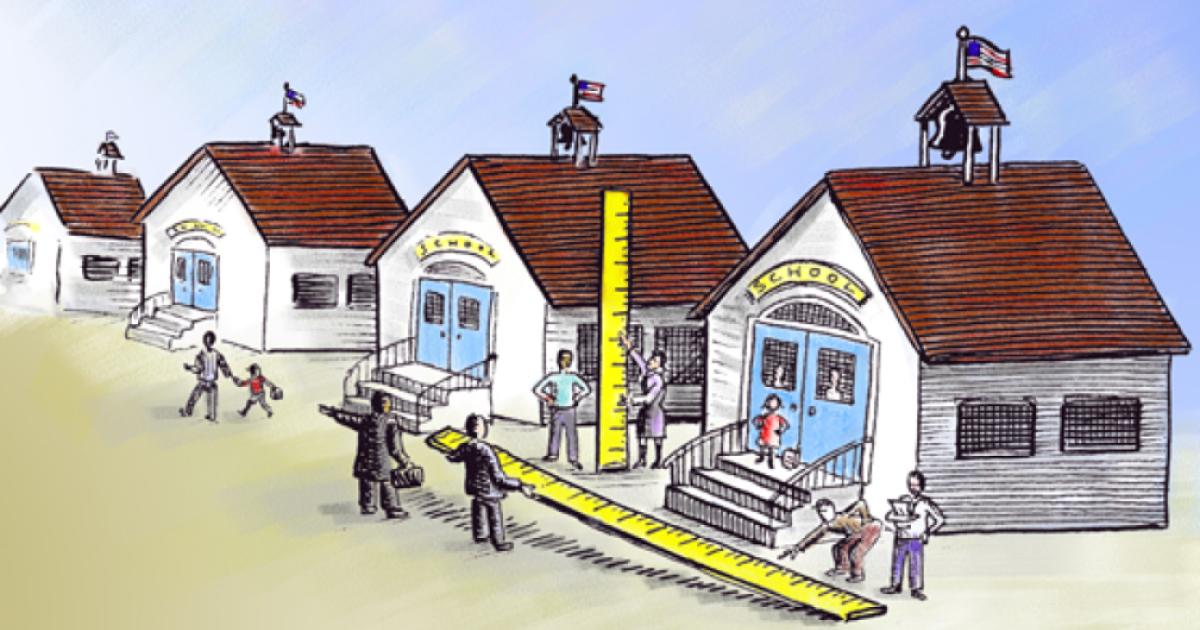- Education
Editor’s note: In this essay, the author blends prediction with prescription to paint a vivid picture of what American education will look like in 2030. The essay is from an online publication of the Hoover Institution’s Koret Task Force on K-12 Education, American Education in 2030.
To be clear, a voucher as the term is used here is a publicly or privately funded scholarship awarded directly to families to pay the costs of the private schools they choose for their children. By 2030, vouchers will have displaced failing public schools, which have long yielded poor results at high costs and have monopolistically confined children to a failing system. Although based largely on facts established by 2010, this essay provides an admittedly speculative account of the rising prevalence of vouchers from the present through 2030 from the hypothetical perspective of 2040.
Because they know best and care most about their children, parents used vouchers to choose the right schools for their children. With vouchers, parents could choose their children’s schools just as they chose their names, food, doctors, and much else. No longer could competing federal, state, and local government officials decide what’s best for students. Just as in competitive markets, vouchers provided incentives and rewards to educators for successes that were missing from public schools. Schools that were most appealing to parents thrived and multiplied; the least appealing ones shrank and closed. The voucher system put in place standards and accountability for both private schools and parents.
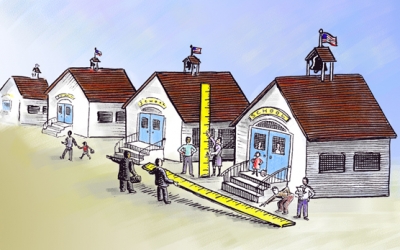
Illustration by Barbara Kelley
Voters demanded that legislators remove dysfunctional programs and regulations that unfairly advantaged some industries, firms, and public organizations over others, including the near monopoly of public schools. Even egalitarians changed their minds about public schools when they realized that traditional public schools contributed less to students from poor and minority families, often in big cities, who often attended poorly performing schools and tended to drop out early.
The seemingly radical, vastly increased privatization of education was in keeping with traditional American ideals of freedom, individualism, and self-determination, making use of Americans’ world-beating optimism and strengths in invention, entrepreneurship, and pragmatism. As a consequence, the private provision of schooling, as in other fields, produced much better achievement outcomes. Following stunning Asian examples of high achievement and fast economic growth, the American economy made commensurate economic strides.
Unlike for-profit organizations, government-provided services and their agencies had been gigantically difficult to change constructively, efficiently, and peaceably. Dominated by traditions and special interests, and subsidized nearly to the point of monopoly, they lacked capitalism’s incentives to invent, improve, and compete to serve customers. An example was the U.S. Postal Service, a subsidizer of unwanted junk mail that was nearly destroyed by e-mail and such private providers as Federal Express and United Parcel Service.
In response to government inefficiencies, privatization of services began as early as the 1970s—for good reasons. Voluminous evidence showed that private organizations generally yielded better results at lower costs. Various experiments in privatizing government services by private nonprofit and for-profit organizations showed that, compared to public agencies, they are more attractive and satisfying to their customers and their employees. Carried out in the United States and other countries, studies of successful privatizations involved airlines, banks, bus service, debt collection, electric utilities, hospitals, insurance, railroads, savings and loans, utilities, and weather forecasting. Governments even privatized prisons, police, fire protection, and public pensions. In the same way that firms outsourced, so too did governments, with better, less costly results.
The resilient U.S. democracy sometimes performs best in a crisis.
The downfall of repeatedly failing public schools accelerated in 2015 not only because of poor results and parent dissatisfaction but because of their threat to the American economy and society. The resilient U.S. democracy sometimes performs best in a crisis. By 2015, citizens had more fully recognized the country’s misfortunes; they wanted efficient government, lower taxes, and more control over their lives.
Government-financed and operated school failures became better known, leading citizens and parents to induce policy makers to more fully privatize K-12 schools.
Private and semiprivate schools flourished by 2030 because distinctively American traditions had reasserted themselves, including the exceptional American preference for individual responsibility over one’s own life and prosperity. Americans were disillusioned about government control and optimistic that individuals could succeed on their own initiative.
Privatizing schools may sound non-traditional and even un-American, but early one-room schools run by nearby citizens were in keeping with the views of the American Founders and the early immigrants who wanted to be free of centralized government control. Later, immigrants came for the same reason as well as to attain the prosperity possible in the nation’s largely free economy.
But beginning a century ago, the control of schools became increasingly centralized, defying the long tradition of local control. Often in conflict, federal, state, and local officials increasingly ruled the public schools. In such a complex and unaccountable system, powerful and sophisticated special interests, particularly public sector unions, overpowered the interests of local citizens and parents and undermined the well-being of students. Boards of consolidated and increasingly larger school districts also failed to represent the students’ best interests.
Even in the for-profit sector, large multi-layered firms falter and fail when their boards and senior executives lose touch with their customers. Some firms learn to do away with dysfunctional layering and thus respond more fully to consumer preferences, reducing costs to turn themselves around. If not, bankruptcy or a takeover by another firm can result, as in the cases of the once-proud Pan American World Airlines and Chicago’s Marshall Fields, originator of the department store. With lean management and superior logistics, Wal-Mart threatens to destroy today’s less-efficient competitors.
And yet, repeatedly failing public schools and school districts seldom closed. Similarly, multibillion-dollar federally-mandated school programs for poor, handicapped, and English-language learners continued largely unreformed for decades even though large-scale evaluations had demonstrated their failure.
Beginning a century ago, the control of schools became increasingly centralized.
By 2015, citizens understood the public school crisis and its prospects for worsening. Even before the turn of the millennium, national surveys showed that Americans had astonishingly strong views about what to do, including demanding more accountability from schools, educators, and students. Many thought students in repeatedly failing schools should be allowed to transfer elsewhere; others saw a need for replacing the faculty or closing such schools altogether. More than eight in ten favored requiring students to pass an examination before moving to the next grade, and 85 percent supported passing an examination to graduate from high school.
Like the public, students thought their schools were lax and lacking standards. For example, a Public Agenda national survey of high school students showed that three-fourths believed stiffer examinations and graduation requirements would make students pay more attention to their studies. More than 70 percent said schools should require after-school classes for those earning Ds and Fs.
Given the public school failures of the last half-century, the substantial progress needed required far more substantial reforms, including the technologies described by education-reform experts John Chubb and Terry Moe, who saw the promise of innovative organizations geared to the new technologies. One discovery of their impressive research was the demand for and rapid growth of virtual, or “cyber,” schools that deliver much of their content and instruction over the internet. By 2010, such virtual schools served some 187,000 students in twenty-four schools, including 62,000 in the Utah Electronic High School and 54,000 in Florida’s Virtual School. Private schools deliver equal or better achievement outcomes and lower costs.
The most important evidence for K-12 privatization was that charter schools, private schools, and vouchers definitively promoted student achievement gains, cost efficiency, and parent satisfaction. Contrary to what some had feared, or alleged that they feared, students in charter and fully private schools were no less “socialized” but rather more often participated in voluntary charitable activities such as tutoring younger and hospitalized children. While in school and as adults, they tended to more often engage in civic affairs such as voting and writing letters to newspapers.
The most definitive studies were the randomized field trials carried out by Paul Peterson on vouchers and Caroline Hoxby on charter schools. They compared the achievement of students in oversubscribed schools into which they were selected by lottery to that of students in the public schools who applied but were not selected in the lottery. Perhaps equally important was the oversubscription itself; the ardent desires of parents to get their children into private and charter schools were an important indicator of school success.
It's ironic that “socialist” Sweden successfully pioneered parental choice of K-12 education.
As John Merrifield points out, however, the potential of school choice and privatization had been underestimated, perhaps because the relatively small numbers of choice schools were insufficient to produce strong competitive effects on other schools. Individual private and charter schools and their organizations, moreover, typically remained small and gained little in economies of scale (that is, lower per-unit costs as they grew larger). Charter schools had also been constrained by some of the same federal, state, and local district regulations that made traditional public schools dysfunctional. Additionally, most private and charter schools lacked the productivity-raising profit motives that lead to superior results.
In its report series “Education at a Glance,” the Organization for Economic and Cooperation and Development (OECD) compiled school trends among its economically advanced member countries. It reported that East Asian countries with large private school sectors and popular for-profit tutoring schools continued to excel on achievement examinations and graduation rates. South Korea, for example, was one of the poorest education performers in the 1970s. By 2010, its high school students’ scores in mathematics and science were near the top. Among the industrialized OECD countries, South Korea ranked first in high school completion rates of adults aged twenty-five to thirty-four: 97 percent.
Unlike the United States, South Korea, Japan, and other East Asian countries funded privately governed schools directly, without the administrative complications of charters and vouchers. Most impressive, however, were the tuition-funded tutoring schools that were free of government regulations. Unlike most public and private schools in the West, South Korea’s for-profit tutoring firms made use of the nation’s internet service—fastest in the world— and paid teachers for their individual performances, often sharing with them the student tuition they generated.
Perhaps even more astonishing was India. Second only to China in population size and economic growth, Indian for-profit firms provided tuition-funded schooling for as little as six dollars a month. But these are East and South Asian countries. Could such things happen in Western countries?
The Swedish government in 1993 required all local education authorities to directly fund privately run schools of choice at a per-student cost close to that of traditional public schools. New schools had to meet several basic requirements, including an open-admission policy, which required schools to admit all applicants regardless of ability, ethnicity, or socioeconomic level.
New private schools were established in a broad cross section of neighborhoods, including high-income areas as well as locales with predominantly working-class and immigrant populations. Indicating bottled-up demand, the number of private schools rose fivefold. The new policy led to increased competitiveness, improved student achievement, and greater parental satisfaction. Unexpectedly, private chains of for-profit schools were founded and grew quickly. In 2008, ten chains each operated more than six schools, and five ran more than ten schools.
It was ironic that, among Western countries, “socialist” Sweden rather “capitalist” America successfully pioneered parental choice of primary and secondary education. But even in 2010, the United States had two huge advantages that would allow it to take the lead in consumer choice in K-12 education by 2030: the longstanding American preference for citizens’ self-determination over government control and Americans’ spirit of invention, innovation, and entrepreneurship.








